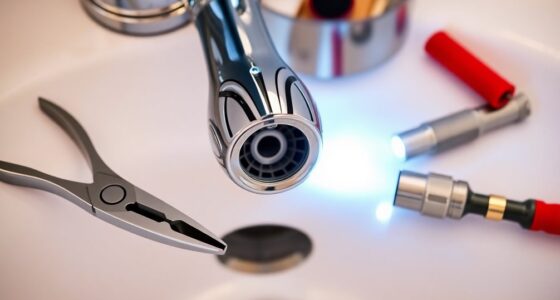To get rid of drywood termites in your kitchen cabinets, start by checking for signs like frass pellets and small holes in the wood. You can use boric acid spray or orange oil on infested areas. For severe cases, consider fumigation or spot treatments with insecticides. Prevent future infestations by maintaining a clear space around cabinets and inspecting regularly. Knowing more about professional services and their benefits can help guarantee lasting results.
Key Takeaways
- Inspect kitchen cabinets regularly for signs of drywood termites, such as frass, discarded wings, and hollow sounds when tapping on wood.
- Apply boric acid spray or orange oil directly to infested wood, as these substances are toxic to termites and can help eliminate them.
- Utilize moistened cardboard traps to attract and dispose of termites, providing an effective method for controlling small infestations.
- Consider professional fumigation or heat treatment for severe infestations, as licensed technicians can ensure thorough eradication and long-term protection.
- Maintain preventive measures by keeping landscaping away from walls and conducting routine inspections to avoid future infestations.
Identifying Drywood Termites in Kitchen Cabinets
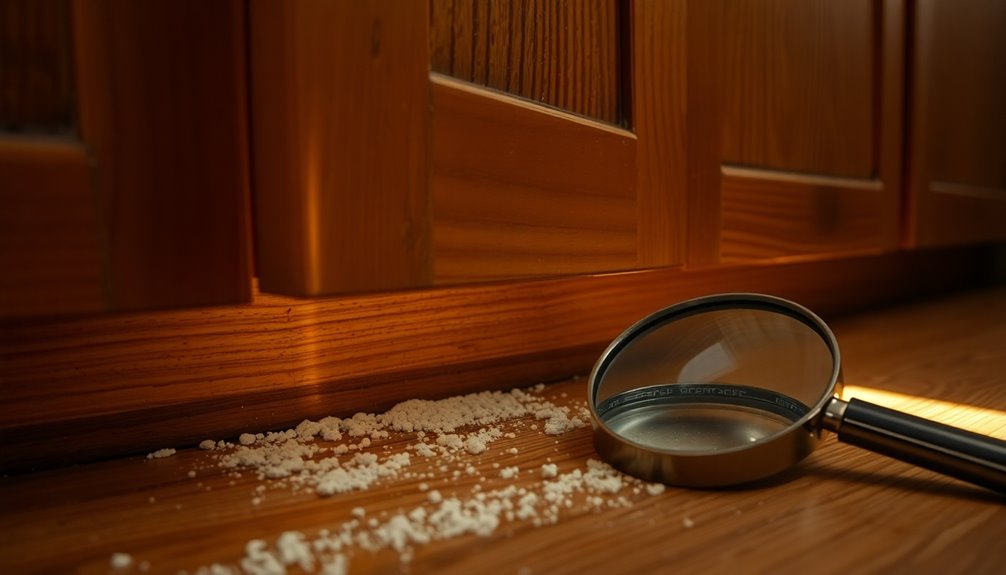
Identifying drywood termites in your kitchen cabinets can save you from costly damage. Look for small, oval-shaped pellets, known as frass, around your cabinets, as these indicate active feeding.
Check for blisters or hollowed areas in the wood; tapping them may produce a hollow sound, revealing hidden termite damage. During mating season, you might spot winged swarmers near windows or light fixtures, which signals a potential infestation.
Additionally, discarded wings found in clusters are clear indicators of drywood termite activity. If you notice unexplained holes or structural weakening in your kitchen cabinets, it's essential to act quickly.
Early detection not only helps protect your cabinets but also prevents further infestation from escalating.
Signs of Termite Infestation
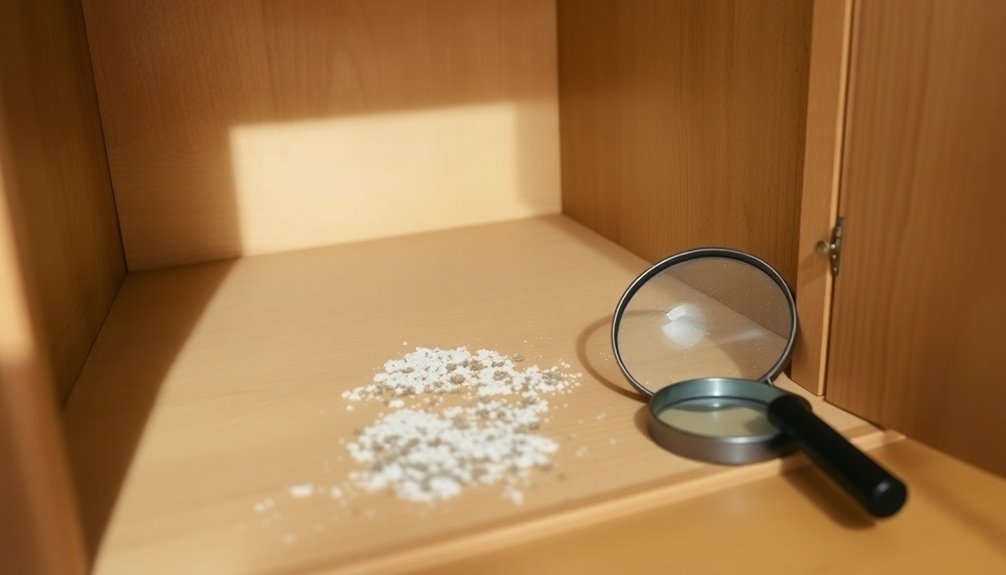
How can you tell if drywood termites have invaded your home? Look for signs of termite infestation in your kitchen cabinets.
Blisters in the wood surface often indicate potential damage lurking beneath. When you tap on the wood, a hollow sound or visible long grooves can signal active termite activity.
Additionally, keep an eye out for discarded wings near windows and doors; this suggests swarming behavior typical of drywood termites. You might also find termite droppings, resembling small pellets, close to infested wood, which indicates ongoing feeding activity.
Prevention Strategies for Drywood Termites
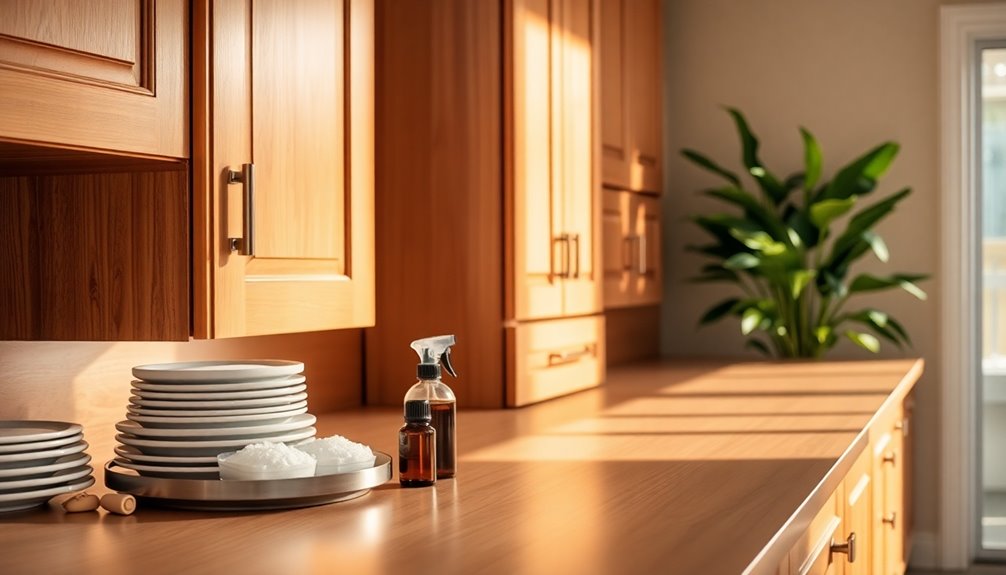
To effectively prevent drywood termites from invading your home, it's crucial to implement proactive measures right from the start.
Maintain at least a 6-inch inspection space around your kitchen cabinets during construction for easy termite control access.
Keep landscape plants at least 2 feet away from exterior walls to help prevent termites from entering.
Regularly trim tree and shrub branches away from walls and roofs to eliminate potential access points.
Verify your soffits are in good repair and screen vents to block pests from getting inside.
Finally, conduct routine inspections of wooden areas in your kitchen for signs of a termite problem, like droppings or hollowed wood.
Catching infestations early is key to effective termite control.
Natural Control Methods for Termites
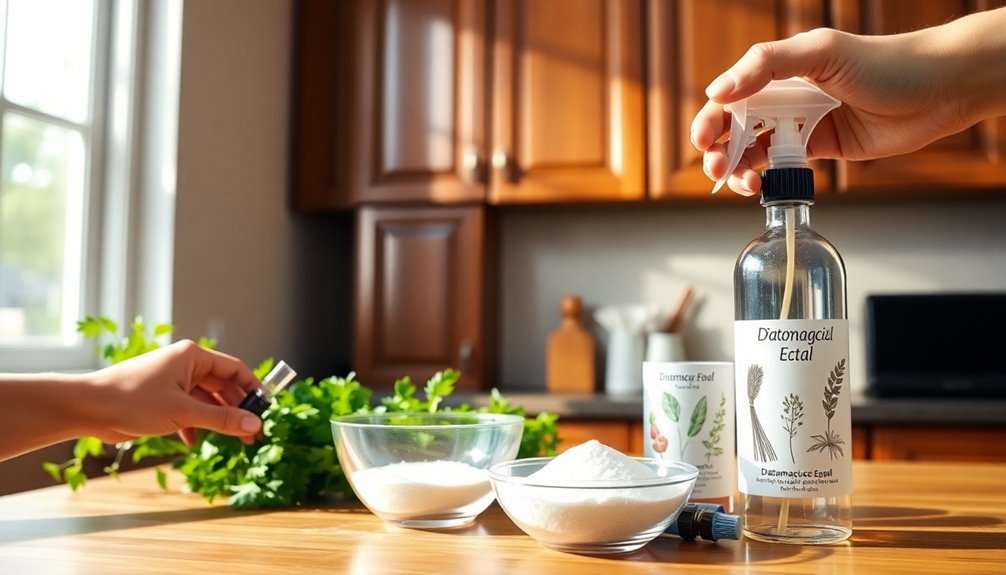
Natural control methods for drywood termites offer effective solutions that are both eco-friendly and easy to implement.
One powerful option is boric acid spray, which dehydrates and damages the termites' exoskeletons without harmful chemicals. You can also use orange oil, known for its toxicity to termites; applying it to infested wood can effectively eliminate them.
For small infestations, consider exposing the affected items to sunlight for 2-3 days, as termites are sensitive to heat and light. Additionally, moistened cardboard traps attract termites, allowing for simple disposal once infested.
Regular inspections and maintaining dry conditions in your kitchen area can further prevent future infestations. By using these natural control methods, you can effectively manage drywood termites in your home.
Spot Treatments for Affected Areas
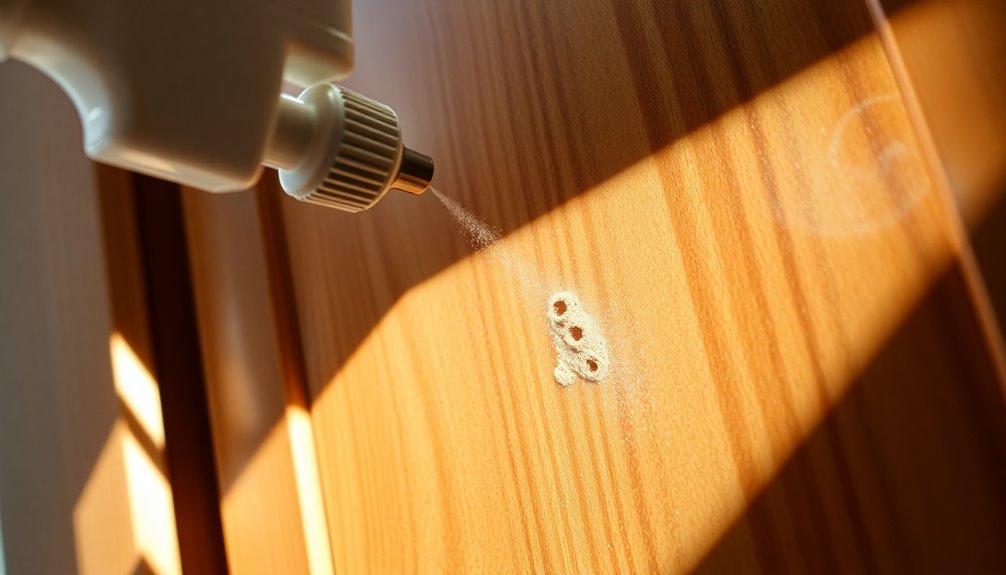
Effective spot treatments can provide a targeted approach to handling drywood termite infestations in your home. By using termiticides like Termidor Foam, you can directly kill the drywood where it's needed most.
Start by locating kickout holes, where you'll find frass or wood pellets, to accurately target your treatment. Drilling holes in the cabinets allows you to inject the foam right into the termite galleries. Use a checkboard drilling pattern, typically every 12 inches, to guarantee thorough coverage and reach hidden tunnels.
Additionally, aerosol products like D Foam, Invader, or Premise Foam can effectively treat specific areas economically. Successful spot treatments can considerably reduce the need for more extensive measures, helping you manage the infestation efficiently.
Fumigation Process for Severe Infestations
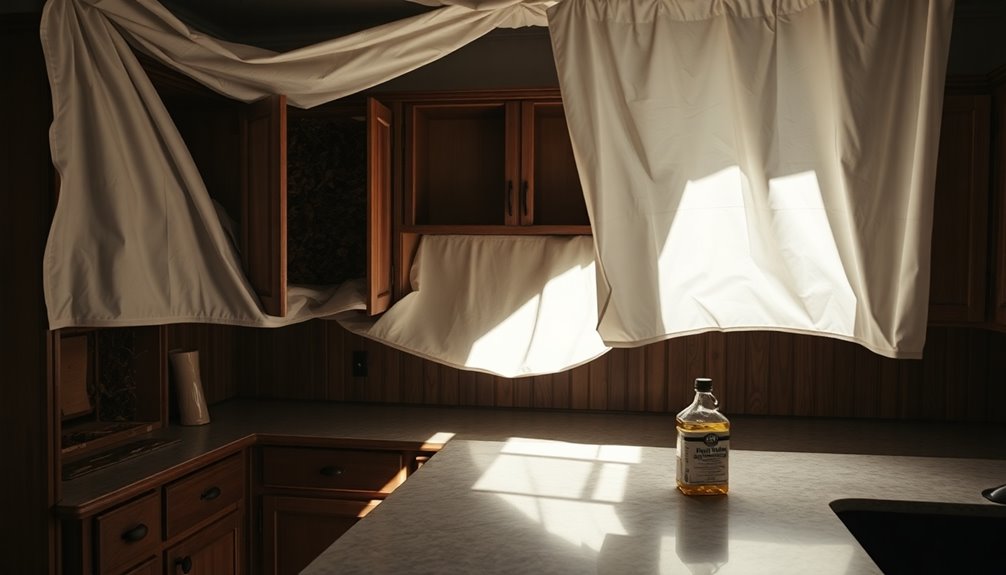
If you're facing a severe drywood termite infestation, fumigation is often the most effective solution.
You'll need to prepare your home by following a specific checklist, and then licensed professionals will tent and seal your property for treatment.
After the process, it's vital to take proper safety measures to guarantee your home is safe to return to.
Fumigation Preparation Checklist
Before you begin the fumigation process for severe termite infestations, it's vital to prepare your home properly to guarantee a safe and effective treatment.
Start with a fumigation preparation checklist provided by your fumigation company. Remove or bag most foods and medications to guarantee safety.
You'll need access to all cabinets, doors, and attic spaces, so open any rooms or safes. Make arrangements for temporary living accommodations, as you must vacate for several days.
Close all windows and doors tightly, and remove unnecessary items to facilitate the treatment.
Finally, communicate any concerns regarding the termites in your kitchen with the fumigation professionals to guarantee they can effectively kill termites during the process.
Tenting and Sealing Process
When you're ready to tackle a severe drywood termite infestation, the tenting and sealing process is a crucial step. This involves covering your entire structure with a heavy-duty tent, ensuring it's sealed tightly to contain the fumigant.
Licensed pest control professionals typically use sulfuryl fluoride (Vikane®), which effectively kills drywood termites. Before fumigation, you'll need to remove or bag most foods, medications, and sensitive items according to the pest control company's checklist.
Fumigation usually lasts several days, so plan for temporary living arrangements. After the tent is removed, proper ventilation is essential to allow the fumigant to dissipate completely, ensuring your home is safe for re-entry.
This thorough process is critical for effective pest control.
Post-Fumigation Safety Measures
After completing the tenting and fumigation process for drywood termites, it's crucial to prioritize safety as you prepare to re-enter your home.
Follow these steps to guarantee a safe return:
- Ventilation: Guarantee thorough ventilation of the treated area for at least 24 hours to let any residual fumigant dissipate.
- Inspect: Carefully inspect all areas for signs of remaining pests and follow up with pest control if necessary.
- Clean: Thoroughly clean cabinets and storage areas to eliminate any lingering fumigant on surfaces.
Avoid re-entering until pest control confirms it's safe, guaranteeing all food and medications are removed or bagged as per their checklist.
Taking these precautions will help maintain a healthy environment post-fumigation.
Preparing for Fumigation
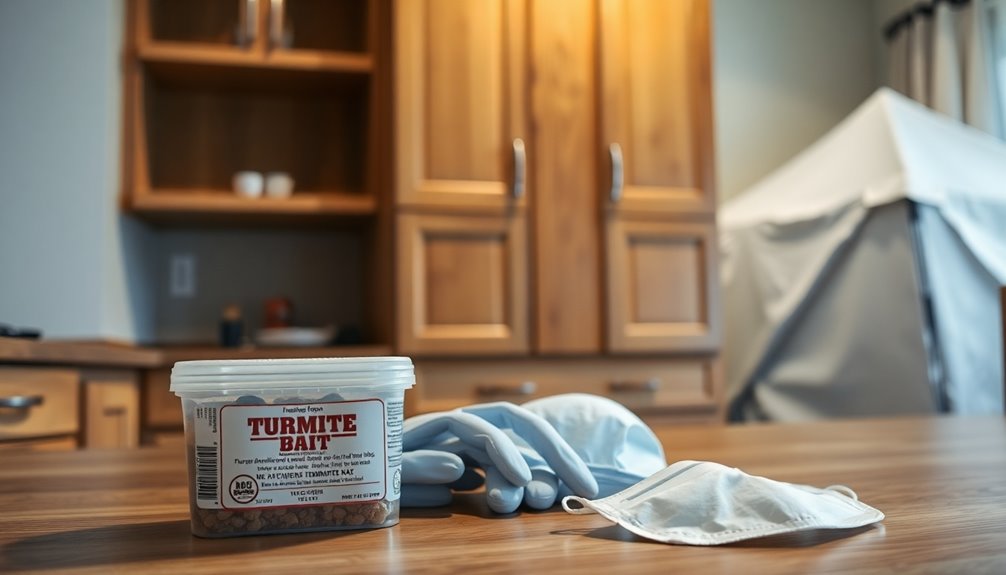
Preparing for fumigation requires careful attention to detail to guarantee the safety and effectiveness of the process. Start by following the detailed checklist from your fumigation company. You'll need to remove or bag most foods and medications, and guarantee access to all cabinets and attic spaces. Don't forget to open any rooms or safes to avoid delays.
Here's a quick checklist to help you:
| Task | Importance | Action |
|---|---|---|
| Remove Foods | Safety | Bag or dispose |
| Open Rooms | Efficiency | Guarantee access |
| Secure Valuables | Protection | Store off-site |
Also, arrange temporary living accommodations, as your home will be unoccupied during the fumigation process.
Professional Pest Control Services
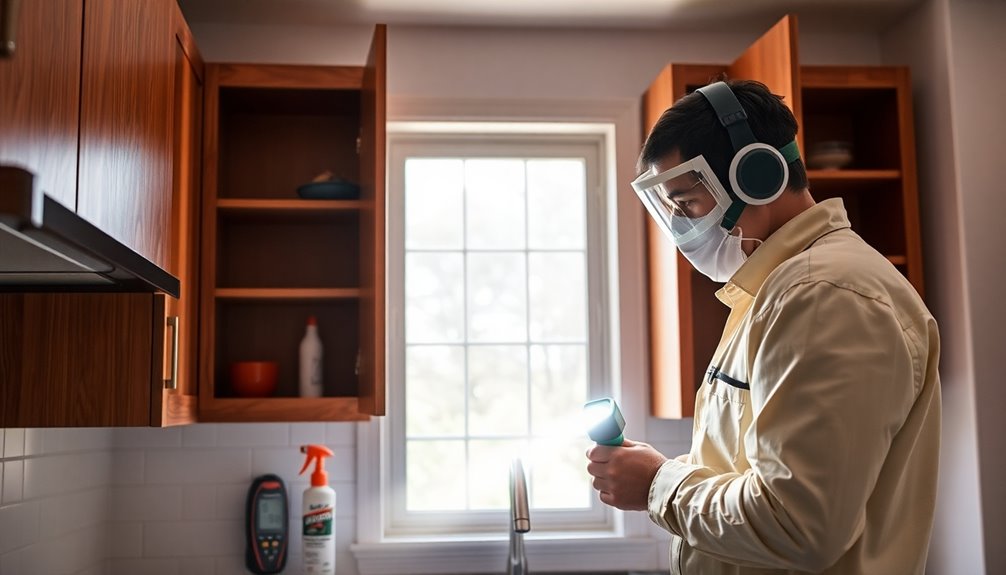
Hiring professional pest control services is essential if you want to effectively tackle a drywood termite infestation.
These experts can help you quickly and efficiently terminate the problem. Here are three key benefits of using their services:
- Specialized Treatments: They utilize advanced methods like fumigation with sulfuryl fluoride (Vikane®) for severe cases.
- Thorough Inspections: Licensed technicians identify the extent of infestations and pinpoint potential entry points, offering preventative solutions.
- Peace of Mind: Many companies provide warranties and follow-up services, ensuring the effectiveness of the eradication process.
Frequently Asked Questions
Can Drywood Termites Go Away?
No, drywood termites won't just go away on their own.
If you notice signs like droppings or damaged wood, it's crucial to act quickly. These pests can thrive for years, causing significant damage if left untreated.
You'll likely need professional pest control to effectively eliminate their colonies, as DIY methods often fall short.
Regular inspections and maintenance can help you catch infestations early, preventing more extensive problems down the line.
How to Protect Kitchen Cabinets From Termites?
To protect your kitchen cabinets, consider a proactive plan.
Prioritize pre-treated wood or non-wood materials, like metal, to deter termites.
Maintain a minimum six-inch space for easy inspections, and keep your kitchen dry and ventilated to thwart moisture-loving pests.
Position plants wisely, two feet away from walls, and regularly check for signs of infestation.
Scheduling yearly professional pest inspections can also guarantee your cabinets stay safe and sound from termites.
What Do Termites in Cabinets Look Like?
When you spot termites in cabinets, you'll usually see small, pale or creamy-colored insects about 1/4 to 1/2 inch long. Some might've wings, especially during swarming season.
Look for signs like tiny pinholes in the wood, which indicate where they've entered or exited. You might also find frass, resembling small pellets, near infested areas.
If you tap the wood and hear a hollow sound, that's another sign of potential termite damage.
What Is the Best DIY Drywood Termite Treatment?
For a DIY drywood termite treatment, consider crafty concoctions!
Boric acid spray is a brilliant choice, killing termites on contact and ingestion.
Alternatively, orange oil can devastate their exoskeletons, leading to dehydration.
Cardboard traps can attract and capture these pests, while sunlight exposure for a few days can deter them.
Finally, using Termidor foam for spot treatments can effectively target hidden colonies.
You've got several effective options at your fingertips!
Conclusion
In summary, dealing with drywood termites in your kitchen cabinets can be intimidating, but you're not alone. Did you know that about 1 in 5 homes in the U.S. are affected by termites at some point? By identifying signs early, implementing prevention strategies, and considering both natural and professional treatments, you can protect your home effectively. Don't wait until it's too late—take action now to safeguard your cabinets and keep your kitchen termite-free!




